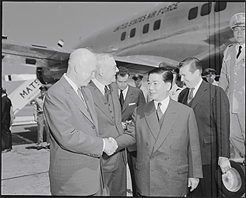VIETNAM WAR
By the late 1950s, after the French loss in 1954 and the failure to hold promised free elections in 1955, civil war raged between North and South Vietnam. President Johnson chose to escalate U.S. involvement during the 1960s after Kennedy's initial use of advisers.
Situation in Vietnam during the 1950s and early 1960s
At an international conference in Geneva, Vietnam was divided with Ho in power in the North and Ngo Dinh Diem, a Roman Catholic anti- Communist in a largely Buddhist population, heading the government in the South. Elections were to be held two years later to unify the country. Persuaded that the fall of Vietnam could lead to the fall of Burma,. Thailand, and Indonesia, Eisenhower backed Diem's refusal to hold elections in 1956 and effectively established South Vietnam as an American client state.
 Kennedy used limited military actions to contain the spread of communism, determined to stand firm against it. His policy included political, economic, and military support for the unstable South Vietnamese government. Guerilla struggle between North and South continued. Diem's unpopularity drew and the military situation worsened. Communist guerillas had organized the National Front for the Liberation of the South Vietnam (NLF) which has ties to the Communist government of the North. South Vietnam leader Ngo Dinh Diem asked for U.S. assistance and military aid and between 1955 and 1961, 650 military advisers were sent to South Vietnam. Kennedy used limited military actions to contain the spread of communism, determined to stand firm against it. His policy included political, economic, and military support for the unstable South Vietnamese government. Guerilla struggle between North and South continued. Diem's unpopularity drew and the military situation worsened. Communist guerillas had organized the National Front for the Liberation of the South Vietnam (NLF) which has ties to the Communist government of the North. South Vietnam leader Ngo Dinh Diem asked for U.S. assistance and military aid and between 1955 and 1961, 650 military advisers were sent to South Vietnam.
To the presidents surprise, Diem and his powerful brother- in –law were killed.
Johnson's Vietnam policy after Kennedy's assassination
Johnson believed that the United States had an obligation to resist communism in Vietnam, and therefore escalated involvement in the war. Initially he sent 5,000 military advisers.
After Communists forces attacked an American base at Pleiku and seven marines died, Johnson ordered bombing on the North.. Such bombing raids continued until 1972. They had little effect, however, in limiting North Vietnamese assistance to the NLF.
Overall number of 100,000 U.S. troops were sent in South Vietnam by 1965, and 500,000 were there by 1967. The quest for victory in Vietnam, considered to be vital to U.S. national security and prestige, had intensified.
Tet Offensive (1968)
With U.S. forces still north at Khe Sanh, the Viet Cong launched the Tet Offensive, the large “general offensive” that Ho Chi Minh and the Vietnamese Communists had been planning for years. On January 30, 1968, on the Vietnamese new year holiday of Tet, separate Viet Cong and NVA cells attacked twenty-seven different U.S. military installations throughout South Vietnam at the same time.
Fighting was intense, but U.S. forces managed to kill or capture the bulk of the Viet Cong raiders within several weeks. The toughest combat occurred in the city of Hue, which the NVA actually conquered for a few weeks before U.S. troops took it back. Fighting occurred as far south as Saigon, taking over the streets. Amid the chaos, an Associated Press photographer captured South Vietnam’s chief of police, Nguyen Ngoc Loan, executing a Viet Cong captain in the streets of Saigon—a brutal image that shocked the American public and became a symbol of the Vietnam quagmire.
Although the Tet Offensive was quashed relatively quickly, it was an enormous political defeat for the U.S. Army and for Johnson because it proved, despite Johnson’s pronouncements, that the war was far from over. The attack not only turned millions of Americans against the war but also split the Democratic Party and the entire U.S. government into antiwar and pro-war factions.
One of the great ironies of the war was the fact that the Tet Offensive was actually a resounding tactical victory for the United States. The NVA gained no territory for more than a brief period, while 40,000 Vietnamese Communist troops died compared to about 3,000 Americans and South Vietnamese combined. The Tet Offensive thus severely damaged Ho Chi Minh’s armies. Nonetheless, the cost in terms of U.S. public opinion would far outweigh the military victory.
|

